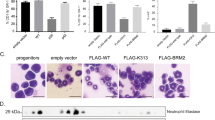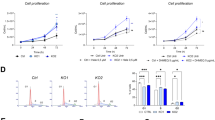Abstract
C/EBPα (p42 and p30 isoforms) is commonly dysregulated in cancer via the action of oncogenes, and specifically in acute myeloid leukaemia (AML) by mutation. Elevated TRIB2 leads to the degradation of C/EBPα p42, leaving p30 intact in AML. Whether this relationship is a cooperative event in AML transformation is not known and the molecular mechanism involved remains elusive. Using mouse genetics, our data reveal that in the complete absence of C/EBPα, TRIB2 was unable to induce AML. Only in the presence of C/EBPα p42 and p30, were TRIB2 and p30 able to cooperate to decrease the latency of disease. We demonstrate that the molecular mechanism involved in the degradation of C/EBPα p42 requires site-specific direct interaction between TRIB2 and C/EBPα p42 for the K48-specific ubiquitin-dependent proteasomal degradation of C/EBPα p42. This interaction and ubiquitination is dependent on a critical C terminal lysine residue on C/EBPα. We show effective targeting of this pathway pharmacologically using proteasome inhibitors in TRIB2-positive AML cells. Together, our data show that excess p30 cooperated with TRIB2 only in the presence of p42 to accelerate AML, and the direct interaction and degradation of C/EBPα p42 is required for TRIB2-mediated AML.
This is a preview of subscription content, access via your institution
Access options
Subscribe to this journal
Receive 50 print issues and online access
$259.00 per year
only $5.18 per issue
Buy this article
- Purchase on Springer Link
- Instant access to full article PDF
Prices may be subject to local taxes which are calculated during checkout






Similar content being viewed by others
References
Fasan A, Alpermann T, Haferlach C, Grossmann V, Roller A, Kohlmann A et al. Frequency and prognostic impact of CEBPA proximal, distal and core promoter methylation in normal karyotype AML: a study on 623 cases. PLoS One 2013; 8: e54365.
Annamaneni S, Kagita S, Gorre M, Digumarti RR, Satti V, Battini MR . Methylation status of CEBPAgene promoter in chronic myeloid leukemia. Hematology 2014; 19: 42–44.
Bennett KL, Hackanson B, Smith LT, Morrison CD, Lang JC, Schuller DE et al. Tumor suppressor activity of CCAAT/enhancer binding protein is epigenetically down-regulated in head and neck squamous cell carcinoma. Cancer Res 2007; 67: 4657–4664.
Paz-Priel I, Friedman A . C/EBPalpha dysregulation in AML and ALL. Crit Rev Oncog 2011; 16: 93–102.
Friedman AD . C/EBPα in normal and malignant myelopoiesis. Int J Hematol 2015; 101: 330–341.
Taskesen E, Bullinger L, Corbacioglu A, Sanders MA, Erpelinck CAJ, Wouters BJ et al. Prognostic impact, concurrent genetic mutations, and gene expression features of AML with CEBPA mutations in a cohort of 1182 cytogenetically normal AML patients: further evidence for CEBPA double mutant AML as a distinctive disease entity. Blood 2011; 117: 2469–2475.
Pabst T, Eyholzer M, Haefliger S, Schardt J, Mueller BU . Somatic CEBPA mutations are a frequent second event in families with germline CEBPA mutations and familial acute myeloid leukemia. J Clin Oncol 2008; 26: 5088–5093.
Fasan A, Haferlach C, Alpermann T, Jeromin S, Grossmann V, Eder C et al. The role of different genetic subtypes of CEBPA mutated AML. Leukemia 2014; 28: 794–803.
Hattori T, Ohoka N, Inoue Y, Hayashi H, Onozaki K . C/EBP family transcription factors are degraded by the proteasome but stabilized by forming dimer. Oncogene 2003; 22: 1273–1280.
Keeshan K, He Y, Wouters BJ, Shestova O, Xu L, Sai H et al. Tribbles homolog 2 inactivates C/EBPalpha and causes acute myelogenous leukemia. Cancer Cell 2006; 10: 401–411.
Keeshan K, Shestova O, Ussin L, Pear WS . Tribbles homolog 2 (Trib2) and HoxA9 cooperate to accelerate acute myelogenous leukemia. Blood Cells Mol Dis 2008; 40: 119–121.
Rishi L, Hannon M, Salomè M, Hasemann M, Frank A-K, Campos J et al. Regulation of Trib2 by an E2F1-C/EBPalpha feedback loop in AML cell proliferation. Blood 2014; 123: 2389–2400.
Keeshan K, Bailis W, Dedhia PH, Vega ME, Shestova O, Xu L et al. Transformation by Tribbles homolog 2 (Trib2) requires both the Trib2 kinase domain and COP1 binding. Blood 2010; 116: 4948–4957.
Mancini E, Sanjuan-Pla A, Luciani L, Moore S, Grover A, Zay A et al. FOG-1 and GATA-1 act sequentially to specify definitive megakaryocytic and erythroid progenitors. EMBO J 2011; 8;:1–15.
Ye M, Zhang H, Amabile G, Yang H, Staber PB, Zhang P et al. C/EBPa controls acquisition and maintenance of adult haematopoietic stem cell quiescence. Nat Cell Biol 2013; 15: 385–394.
Hasemann MS, Lauridsen FKB, Waage J, Jakobsen JS, Frank A-K, Schuster MB et al. C/EBPα is required for long-term self-renewal and lineage priming of hematopoietic stem cells and for the maintenance of epigenetic configurations in multipotent progenitors. PLoS Genet 2014; 10: e1004079–e1004079.
Zhang P, Iwasaki-Arai J, Iwasaki H, Fenyus ML, Dayaram T, Owens BM et al. Enhancement of hematopoietic stem cell repopulating capacity and self-renewal in the absence of the transcription factor C/EBP alpha. Immunity 2004; 21: 853–863.
Ohlsson E, Hasemann MS, Willer A, Lauridsen FK, Rapin N, Jendholm J et al. Initiation of MLL-rearranged AML is dependent on C/EBPα. J Exp Med 2013; 211: 5–13.
Collins C, Wang J, Miao H, Bronstein J, Nawer H, Xu T et al. C/EBP is an essential collaborator in Hoxa9/Meis1-mediated leukemogenesis. Proc Natl Acad Sci USA 2014; 111: 9899–9904.
Wagner K, Zhang P, Rosenbauer F, Drescher B, Kobayashi S, Radomska HS et al. Absence of the transcription factor CCAAT enhancer binding protein alpha results in loss of myeloid identity in bcr/abl-induced malignancy. Proc Natl Acad Sci USA 2006; 103: 6338–6343.
Pabst T, Mueller BU, Zhang P, Radomska HS, Narravula S, Schnittger S et al. Dominant-negative mutations of CEBPA, encoding CCAAT/enhancer binding protein-alpha (C/EBPalpha), in acute myeloid leukemia. Nat Genet 2001; 27: 263–270.
Leroy H, Roumier C, Huyghe P, Biggio V, Fenaux P, Preudhomme C . CEBPA point mutations in hematological malignancies. Leukemia 2005; 19: 329–334.
Bereshchenko O, Mancini E, Moore S, Bilbao D, Månsson R, Luc S et al. Hematopoietic stem cell expansion precedes the generation of committed myeloid leukemia-initiating cells in C/EBPα mutant AML. Cancer Cell 2009; 16: 390–400.
Quintana-Bustamante O, Lan-Lan Smith S, Griessinger E, Reyal Y, Vargaftig J, Lister TA et al. Overexpression of wild-type or mutants forms of CEBPA alter normal human hematopoiesis. Leukemia 2012; 26: 1537–1546.
Kirstetter PP, Schuster MB, Bereshchenko OO, Moore SS, Dvinge HH, Kurz EE et al. Modeling of C/EBPalpha mutant acute myeloid leukemia reveals a common expression signature of committed myeloid leukemia-initiating cells. Cancer Cell 2008; 13: 299–310.
Yokoyama T, Toki T, Aoki Y, Kanezaki R, Park M-J, Kanno Y et al. Identification of TRIB1 R107L gain-of-function mutation in human acute megakaryocytic leukemia. Blood 2012; 119: 2608–2611.
Carnicer MJ, Lasa A, Buschbeck M, Serrano E, Carricondo M, Brunet S et al. K313dup is a recurrent CEBPA mutation in de novo acute myeloid leukemia (AML). Ann Hematol 2008; 87: 819–827.
Brouwer AJ, Jonker A, Werkhoven P, Kuo E, Li N, Gallastegui N et al. Peptido sulfonyl fluorides as new powerful proteasome inhibitors. J Med Chem 2012; 55: 10995–11003.
Claudia Andreu-Vieyra JRB, Berenson JR . Carfilzomib in multiple myeloma. Expert Opin Biol Ther 2014; 14: 1685–1699.
Grandinetti KB, Stevens TA, Ha S, Salamone RJ, Walker JR, Zhang J et al. Overexpression of TRIB2 in human lung cancers contributes to tumorigenesis through downregulation of C/EBPalpha. Oncogene 2011; 14: 1–8.
Wouters BJ, Jorda MA, Keeshan K, Louwers I, Erpelinck-Verschueren CA, Tielemans D et al. Distinct gene expression profiles of acute myeloid/T-lymphoid leukemia with silenced CEBPA and mutations in NOTCH1. Blood 2007; 110: 3706–3714.
Geletu M, Balkhi MY, Peer Zada AA, Christopeit M, Pulikkan JA, Trivedi AK et al. Target proteins of C/EBP p30 in AML: C/EBP p30 enhances sumoylation of C/EBP p42 via up-regulation of Ubc9. Blood 2007; 110: 3301–3309.
Pulikkan JA, Dengler V, Zada AAP, Kawasaki A, Geletu M, Pasalic Z et al. Elevated PIN1 expression by C/EBPalpha-p30 blocks C/EBPalpha-induced granulocytic differentiation through c-Jun in AML. Leukemia 2010; 24: 914–923.
Trivedi AK, Bararia D, Christopeit M, PeerZada AA, Singh SM, Kieser A et al. Proteomic identification of C/EBP-DBD multiprotein complex: JNK1 activates stem cell regulator C/EBPα by inhibiting its ubiquitination. Oncogene 2006; 26: 1789–1801.
Jin G, Yamazaki Y, Takuwa M, Takahara T, Kaneko K, Kuwata T et al. Trib1 and Evi1 cooperate with Hoxa and Meis1 in myeloid leukemogenesis. Blood 2007; 109: 3998–4005.
Xu S, Tong M, Huang J, Zhang Y, Qiao Y, Weng W et al. TRIB2 inhibits Wnt/beta-Catenin/TCF4 signaling through its associated ubiquitin E3 ligases, beta-TrCP, COP1 and Smurf1, in liver cancer cells. FEBS Lett 2014; 588: 4334–4341.
Frank R . The SPOT-synthesis technique. Synthetic peptide arrays on membrane supports—principles and applications. J Immunol Methods 2002; 267: 13–26.
Colleran A, Collins PE, O'Carroll C, Ahmed A, Mao X, McManus B et al. Deubiquitination of NF-kappaB by ubiquitin-specific protease-7 promotes transcription. Proc Natl Acad Sci USA 2013; 110: 618–623.
Acknowledgements
We thank all the technical staff at the Paul O’Gorman Leukaemia Research Centre. We thank the Cancer Research UK Glasgow Centre (C596/A18076) and the Biological Service Unit facilities at the Cancer Research UK Beatson Institute (C596/A17196) and the Biological Services at the University of Glasgow. We thank Ruaidhrí Carmody for reagents and critical review of the work. We thank the Kay Kendall foundation (KKL501) and the Howat foundation for Flow cytometry facility funding. Work in the Keeshan lab was supported by the Howat Foundation and Children with Cancer UK. CO’C was supported by Childrens Leukaemia Research Project grant. PK was supported by Science Foundation Ireland Infrastructure award and the Mid-Western Cancer Foundation. Work in the Porse lab was supported by a centre grant from the NovoNordisk Foundation (The Novo Nordisk Foundation Section for Stem Cell Biology in Human Disease).
Author contributions
KK designed the study. FL, CO’C, CF, EO, MS and JC performed the research. BP provided transgenic mouse models. BP, PK, RL, RA and MC provided essential reagents and expertise. KK, FL, CO’C, MS, EO and JC analysed the data. CO’C and FL made the figures. KK wrote the paper. All authors edited the paper.
Author information
Authors and Affiliations
Corresponding author
Ethics declarations
Competing interests
The authors declare no conflict of interest.
Additional information
Supplementary Information accompanies this paper on the Oncogene website
Rights and permissions
About this article
Cite this article
O'Connor, C., Lohan, F., Campos, J. et al. The presence of C/EBPα and its degradation are both required for TRIB2-mediated leukaemia. Oncogene 35, 5272–5281 (2016). https://doi.org/10.1038/onc.2016.66
Received:
Revised:
Accepted:
Published:
Issue Date:
DOI: https://doi.org/10.1038/onc.2016.66
This article is cited by
-
TRIB3 confers radiotherapy resistance in esophageal squamous cell carcinoma by stabilizing TAZ
Oncogene (2020)
-
TRIB3 supports breast cancer stemness by suppressing FOXO1 degradation and enhancing SOX2 transcription
Nature Communications (2019)
-
TRIB2 regulates the differentiation of MLL–TET1 transduced myeloid progenitor cells
Journal of Molecular Medicine (2018)
-
Trib2 regulates the pluripotency of embryonic stem cells and enhances reprogramming efficiency
Experimental & Molecular Medicine (2017)



